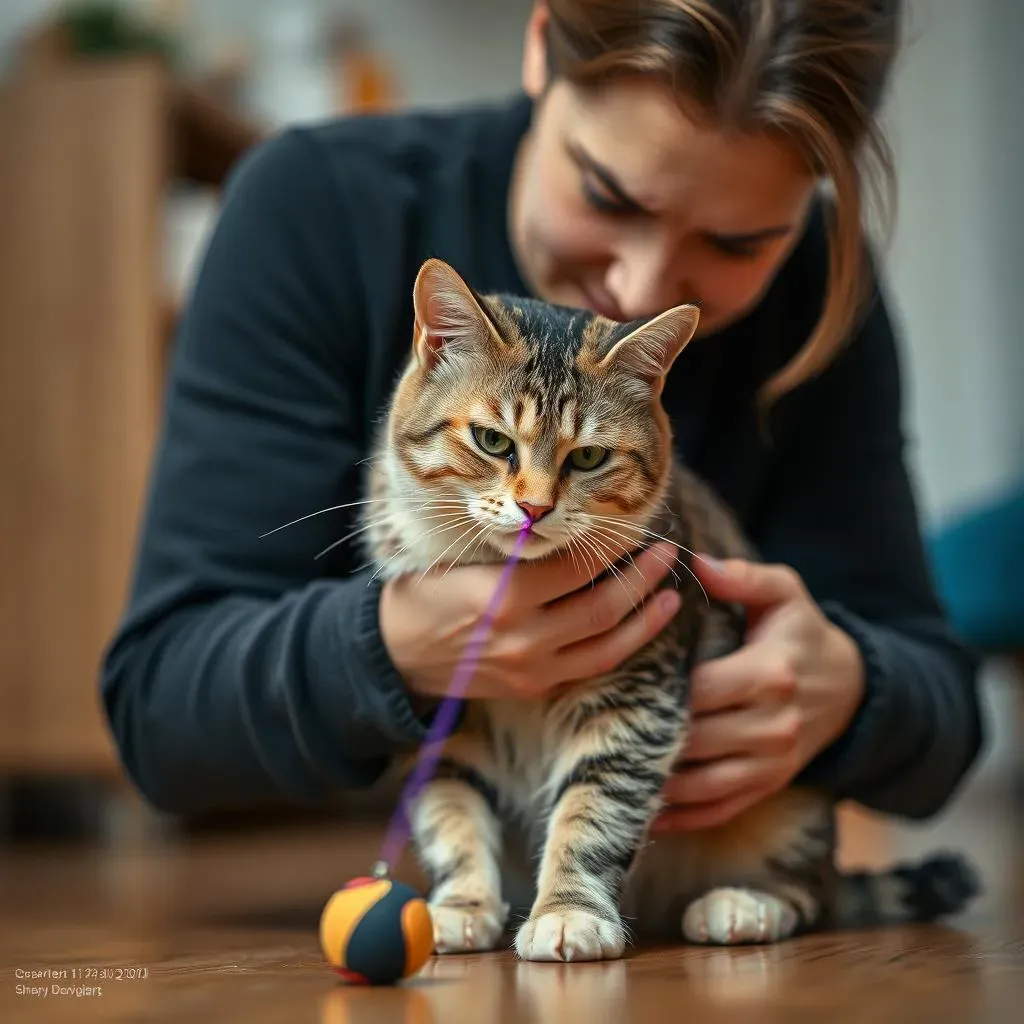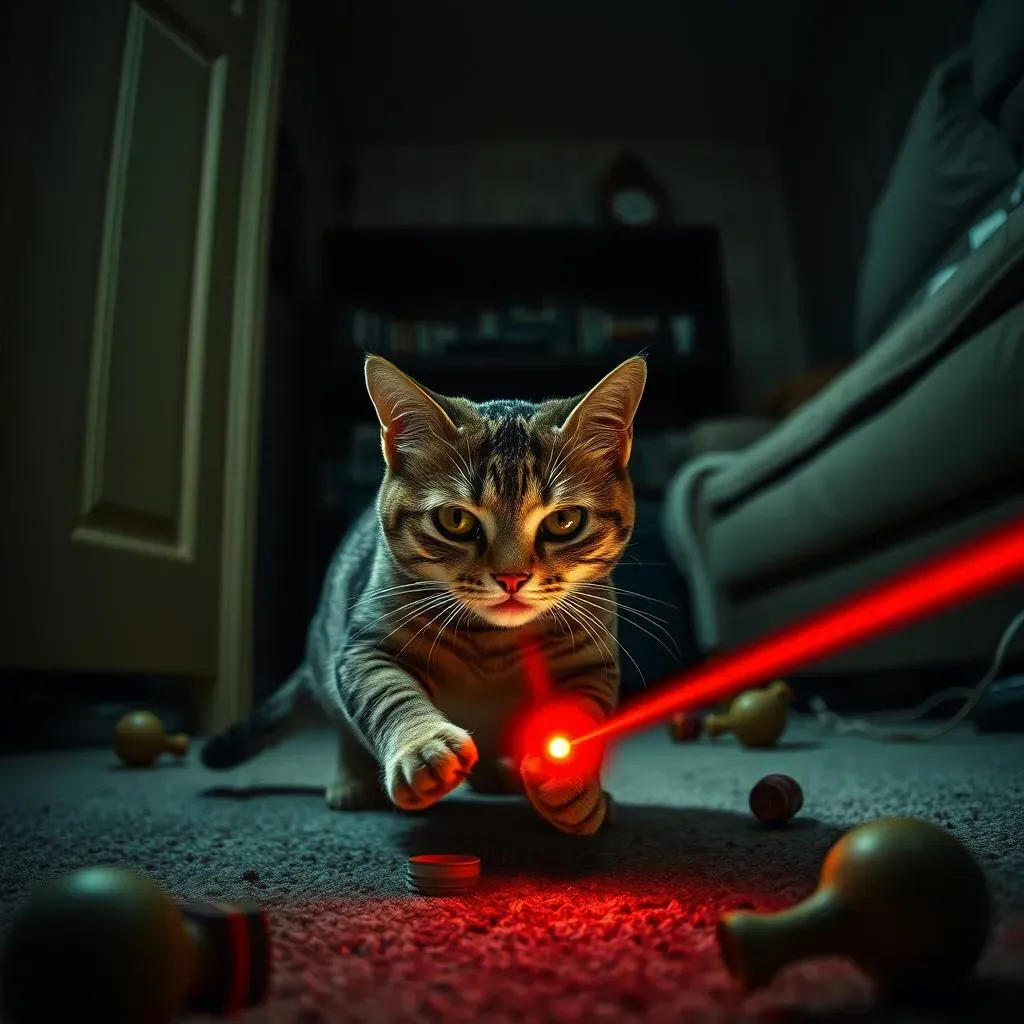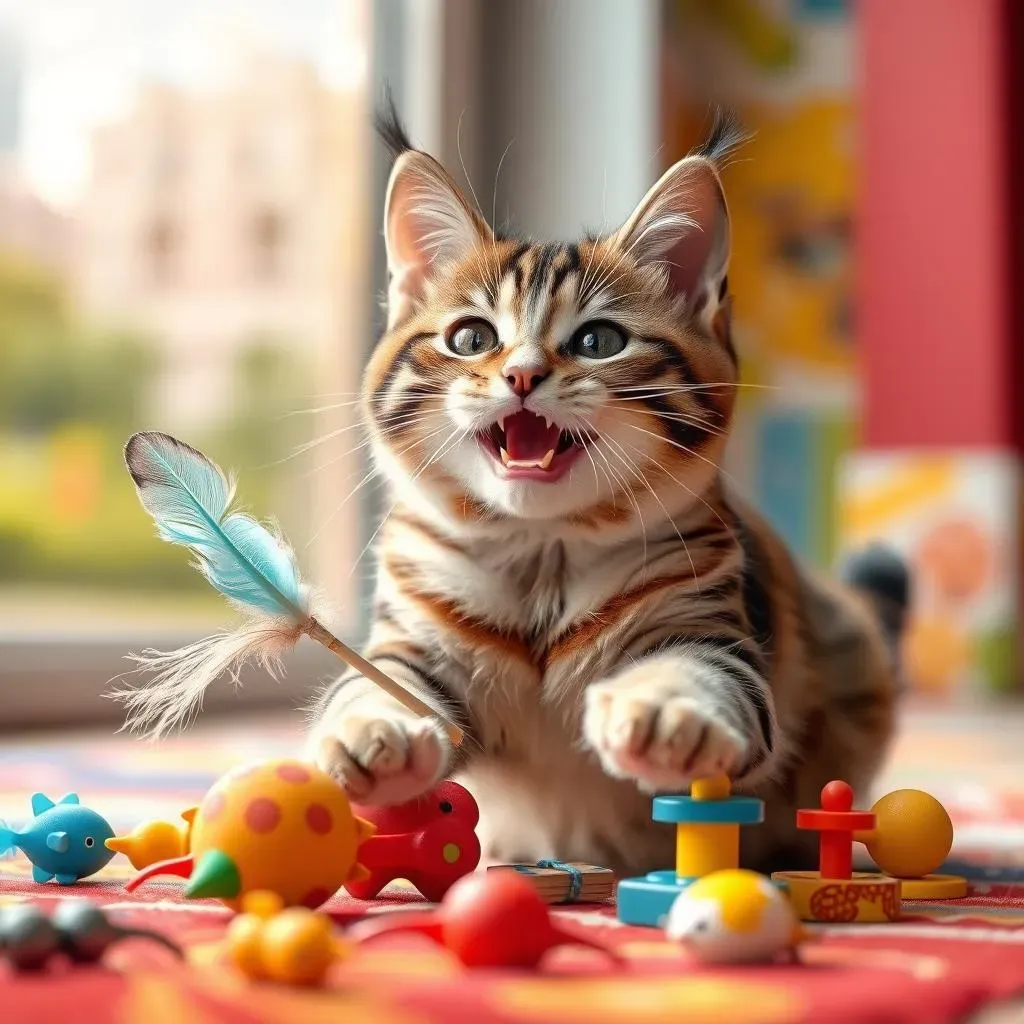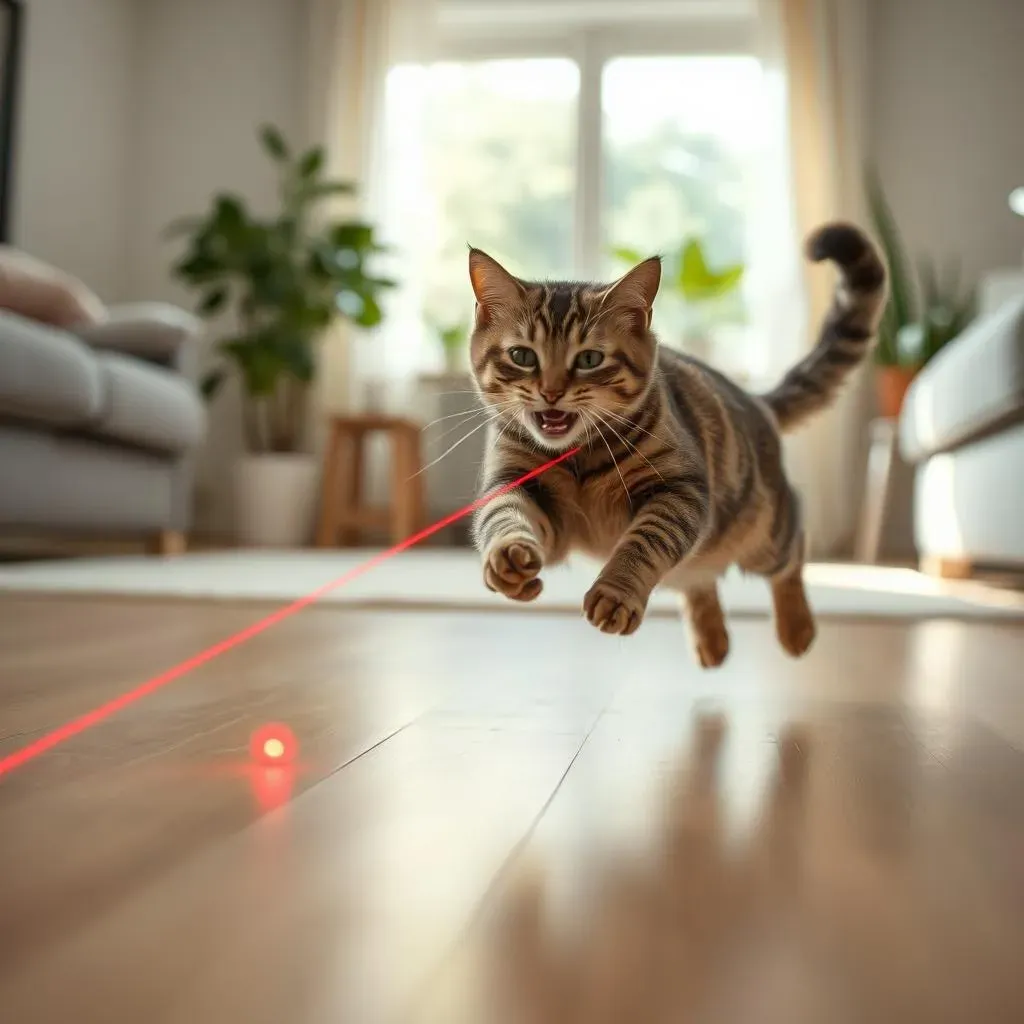Table of Contents
That little red dot, it's like catnip in laser form, right? Many of us cat owners have seen our feline friends go wild chasing a laser pointer. But, have you ever stopped to wonder, "is laser toy bad for cats?" It's a valid question, and the answer is a bit more complex than a simple yes or no. In this article, we’ll explore the potential hazards of laser toys, not just the physical ones like eye safety, but also the psychological impacts they can have on our furry buddies. We'll look at how these toys might be frustrating your cat and what you can do about it. We will discuss safe play practices and some alternative toys for your cat. So, get comfy, and let’s shine a light on whether laser pointers are truly a good idea for our beloved cats.
Laser Toy Safety: Protecting Your Cat's Eyes

Laser Toy Safety: Protecting Your Cat's Eyes
The Bright Side of Lasers: A Quick Look at the Risks
Okay, let's be real, cats and lasers are like peanut butter and jelly, they just go together. That little red dot sends them into a frenzy. But, here's the thing, those lasers aren't toys, they're actually tools that emit a concentrated beam of light. And, just like how you wouldn't stare directly at the sun, you shouldn't shine a laser directly into your cat's eyes. It's not about being a buzzkill; it's about protecting those precious peepers. Think of it like this: you wouldn’t want someone shining a bright light in your eyes, right? Same goes for our feline friends.
The real danger lies in the intensity of the light. While most cat laser toys are low-powered, there's still a risk. A brief flash might not cause immediate harm, but prolonged or repeated exposure could lead to some serious eye damage. I'm talking about the kind of damage that can cause real problems for your cat's vision. It's like if you were playing with a magnifying glass and the sun, you wouldn't want to focus the light on your skin for too long, would you? It's the same principle, and it's why we need to be extra careful with these toys.
Risk | Description | Prevention |
|---|---|---|
Eye Damage | Direct exposure to laser light can harm the retina. | Never shine the laser directly at your cat's eyes. |
Accidental Exposure | Leaving laser pointers where cats can reach them can lead to unsupervised play. | Store laser toys in a secure place, out of your cat's reach. |
Overstimulation | Excessive laser play can cause stress and anxiety. | Limit play sessions and mix with other types of toys. |
Safe Laser Practices: How to Play it Smart
So, what's the solution? Do we banish all lasers from the kingdom? No, not necessarily. It's all about being smart and responsible. First, you need to make sure the laser you're using is a low-powered one. Most cat toys are, but it's always a good idea to double-check. Think of it like buying sunscreen, you want to make sure it has the right SPF, right? It's the same thing with laser toys. If it's too strong, it's not worth the risk. And the number one rule? Never point it directly into your cat's eyes! Instead, keep the dot moving on the floor, or up the wall, but never at their face.
Another thing to consider is where you store the laser. Don't just leave it lying around where your cat can get to it. I mean, a cat with a laser pointer, unsupervised? That's a recipe for disaster. Think of it like leaving a jar of cookies within reach of a toddler – it's just asking for trouble. Keep the laser in a safe place, somewhere your cat can't get to it. This way, you control when and how they play with it, making sure they don't get hurt.
The Psychological Impact of Laser Toys on Cats

The Psychological Impact of Laser Toys on Cats
The Frustration Factor: When the Hunt Never Ends
Okay, so we've covered the physical safety, but what about what's going on in your cat's head? Imagine you're chasing something you can never catch. It's like being in a video game where the final boss is unbeatable. That's kind of how it feels for our cats when they're playing with a laser pointer. They're natural hunters, after all. They have this strong instinct to stalk, chase, and finally, catch their prey. When they're chasing that little red dot, they get all hyped up. But, unlike a real hunt, there’s no satisfying pounce, no victory. This lack of a "catch" can actually lead to frustration and, in some cases, even behavioral issues. It’s like dangling a carrot in front of someone and then snatching it away every single time. Not cool, right?
This constant chase without a reward can be really stressful for some cats. They might start getting overly fixated on the laser, becoming almost obsessive about it. It's like they're stuck in a loop, always wanting more of the chase but never getting the satisfaction of the catch. You might see them start to become more aggressive, or they might start exhibiting other strange behaviors, like excessive grooming or even inappropriate scratching. It's their way of trying to deal with the pent-up energy and frustration. It's not that they're being "bad" cats, it's that they're trying to cope with a situation that doesn't make sense to them.
Psychological Effect | Description | Potential Outcome |
|---|---|---|
Frustration | The inability to catch the laser dot can cause frustration. | May lead to behavioral issues like aggression or excessive grooming. |
Obsessive Behavior | Cats may become overly fixated on the laser pointer. | Can cause anxiety and stress due to the constant chase without reward. |
Redirected Aggression | Frustration can lead to cats redirecting their aggression towards other objects or people. | Increased scratching, biting, or other unwanted behaviors. |
The Importance of the "Catch": Providing Closure
So, what can we do about this? Well, it's not about ditching the laser completely, it's about understanding that cats need a sense of closure. They need to feel like they've actually "won" the hunt. This is why it's a good idea to end a laser pointer play session with a toy they can actually catch. It’s like when you’re playing tag and someone finally gets tagged, there’s a sense of completion. For your cat, this could be a toy mouse, a feather wand, or even a treat they can pounce on. The idea is to give them that final moment of satisfaction that a laser pointer alone can’t provide. It’s about creating a more balanced play experience.
Think of it this way: if you were playing a game and there was never a winner, you'd probably feel a bit cheated, right? Same goes for our feline friends. They need that moment of victory to feel content and fulfilled. By incorporating a physical "catch" into their laser play, we're not just making play time more fun, we're also making it more mentally healthy for them. It's about making sure that their hunting instincts are satisfied, not just teased. This little change can go a long way in keeping your cat happy and well-adjusted.
Is Laser Toy Bad? Alternatives for Playtime

Is Laser Toy Bad? Alternatives for Playtime
Beyond the Beam: Exploring Other Play Options
Alright, so we've established that lasers, while fun, aren't the be-all and end-all for cat playtime. The good news is, there's a whole world of toys out there that can keep your cat entertained and satisfied. Think of it like having a variety of tools in your toolbox; you wouldn't just rely on a hammer, would you? For our feline friends, variety is key. We need to offer them toys that engage their hunting instincts in a more complete way. This means toys they can chase, pounce on, and yes, actually catch! It's about giving them a more fulfilling play experience, where they get to feel like the awesome predators they are.
One of my personal favorites is the classic feather wand. It's like bringing the great outdoors inside. You can make it dance, fly, and dart around, mimicking the movement of a bird or a bug. And the best part? Your cat can actually grab it! It gives them that satisfying "catch" that a laser pointer can't. Other great options include toy mice, crinkle balls, and even puzzle toys. These types of toys not only provide physical exercise but also mental stimulation. It's like giving them a workout for their body and their brain. And trust me, a mentally engaged cat is a happy cat. It's about creating a play environment that's both fun and enriching.
Alternative Toy | Description | Benefits |
|---|---|---|
Feather Wand | A wand with feathers or ribbons attached. | Mimics natural prey, encourages chasing and pouncing. |
Toy Mice | Small, plush toys that resemble mice. | Satisfies hunting instincts, provides a "catch". |
Puzzle Toys | Toys that require cats to solve a puzzle to get a treat. | Provides mental stimulation, reduces boredom. |
Mixing it Up: Creating a Balanced Playtime
The key to keeping your cat happy and healthy is variety. Don't just stick to one type of toy; mix it up! Think of it like planning a balanced meal, you wouldn't just eat one thing, right? The same goes for play. Alternate between toys that encourage chasing, toys that encourage pouncing, and toys that encourage problem-solving. This will keep your cat engaged and prevent them from getting bored. It's like giving them a new adventure every time they play. And don't forget about interactive play! Get down on the floor with your cat and engage with them. This strengthens your bond and makes playtime even more fun for both of you.
Another great idea is to try teaching your cat tricks. Some cats can be taught to fetch, sit, and even high-five! It's a great way to provide mental stimulation and keep them engaged. It's like giving them a puzzle to solve, and they love a good challenge. You can also try hiding treats around the house and letting them "hunt" for them. This satisfies their natural hunting instincts and provides a fun and rewarding experience. The goal is to make playtime an enriching and enjoyable experience for your cat, one that leaves them feeling satisfied and content. Remember, play isn’t just about burning energy; it's also about bonding, learning, and having fun.
Ensuring Safe and Happy Play with Laser Toys

Ensuring Safe and Happy Play with Laser Toys
The Golden Rules of Laser Play
Alright, so you’re still keen on using that laser pointer? I get it, they're fun. But, let’s make sure we’re doing it right. First things first, it’s all about moderation. Don't make laser play the only form of entertainment for your cat. Think of it like eating dessert, it's okay in small amounts, but you wouldn't want it for every meal. Keep the laser sessions short, maybe just a few minutes at a time. This will prevent your cat from getting overly fixated or frustrated. It's about keeping it fun, not turning it into an obsession. And remember, always end the session with a physical toy they can catch. It's like giving them a reward for all their hard work, a little "congratulations, you caught the thing" moment.
Another thing to always keep in mind is the environment. Make sure the area where your cat is playing is safe. You don’t want them tripping over furniture or running into things while they're chasing that little red dot. Clear the area of any obstacles, and make sure there are no sharp objects they could accidentally hurt themselves on. It's like when you're setting up a play area for a kid, you want to make sure it's safe and secure. And, as I mentioned before, never, ever point the laser directly into your cat's eyes. It's the number one rule of laser play, and it's non-negotiable. Keep the beam moving on the floor or up the wall, and always be aware of where it's pointing.
Rule | Description | Why it Matters |
|---|---|---|
Moderation | Keep laser sessions short and infrequent. | Prevents overstimulation and frustration. |
Safe Environment | Clear the play area of obstacles and hazards. | Protects your cat from injury during play. |
Eye Safety | Never shine the laser directly into your cat's eyes. | Prevents potential eye damage. |
Reading Your Cat's Cues: Knowing When to Stop
Every cat is different, and some might be more sensitive to laser play than others. It's important to pay attention to your cat's behavior and learn to recognize the signs that they're not enjoying it anymore. If you see that your cat is getting overly agitated, frustrated, or stressed, it’s time to stop. It’s like when you're playing a game and someone's getting upset, it's time to take a break. Watch out for signs like excessive panting, dilated pupils, or a change in their body language. These are all signals that they've had enough and it's time to switch to a different activity. It's all about being a responsible pet owner and making sure that playtime is a positive experience for your cat.
And remember, the goal of playtime is to enrich your cat’s life, not just to entertain them. It’s about providing them with physical exercise, mental stimulation, and a sense of accomplishment. The laser pointer can be a part of that, but it should never be the whole picture. Mix it up with different types of toys and activities, and always be mindful of your cat’s individual needs and preferences. It’s about creating a balanced and fulfilling play experience that leaves them happy, healthy, and content. It’s like being a good friend, you want to make sure that your cat is having fun, but also that they’re safe and comfortable.